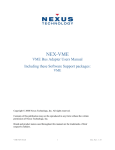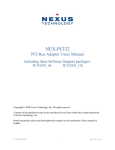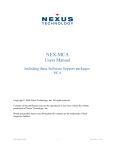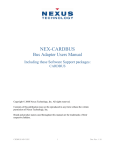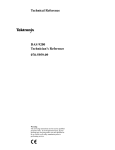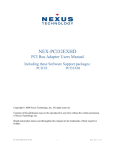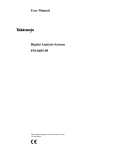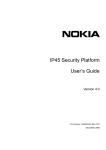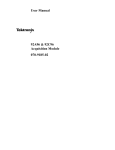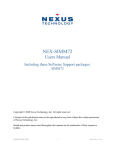Download NEX-ISA Manual
Transcript
NEX-ISA ISA Bus Support Users Manual Including these Software Support packages: ISA Copyright © 2008 Nexus Technology, Inc. All rights reserved. Contents of this publication may not be reproduced in any form without the written permission of Nexus Technology, Inc. Brand and product names used throughout this manual are the trademarks of their respective holders. ISA-MN-XXX 1 Doc. Rev. 1.10 Warranty Terms and License Agreement For warranty terms, refer to the Terms and Conditions of Sale document that was included in the product shipment. The Software License Agreement is displayed during installation. A hardcopy of that agreement may be obtained from Nexus Technology. All Nexus Technology products to which this manual refers are subject to the Terms and Conditions of Sale document and the Software License Agreement, as appropriate. Compliance with WEEE and RoHS Directives This product is subject to European Union regulations on Waste Electrical and Electronics Equipment. Return to Nexus Technology for recycle at end of life. Costs associated with the return to Nexus Technology are the responsibility of the sender. ISA-MN-XXX 2 Doc. Rev. 1.10 TABLE OF CONTENTS 1.0 OVERVIEW ........................................................................................................................... 4 1.1 General Information............................................................................................................ 4 2.0 SOFTWARE INSTALLATION ............................................................................................. 4 2.1 TLA600/700........................................................................................................................ 4 2.2 DAS9200............................................................................................................................. 5 3.0 CONFIGURING the NEX-ISA BUS ADAPTER .................................................................. 5 3.1 General Information............................................................................................................ 5 4.0 CONNECTING to the NEX-ISA ADAPTER ........................................................................ 5 4.1 General................................................................................................................................ 5 4.2 TLA600/700........................................................................................................................ 5 4.3 92A96.................................................................................................................................. 6 5.0 CLOCK SELECTION ............................................................................................................ 8 5.1 General Information............................................................................................................ 8 5.2 Clocking Options - Explanation ......................................................................................... 8 6.0 VIEWING DATA ................................................................................................................... 8 6.1 Viewing State Data on the TLA600/700 ............................................................................ 8 6.2 Viewing Timing Data on the TLA600/700....................................................................... 11 6.3 Viewing State Data on the DAS9200/TLA500 ................................................................. 12 6.4 Viewing Timing Data on the DAS9200/TLA500.............................................................. 12 APPENDIX A - Necessary Signals for Clocking ......................................................................... 13 APPENDIX B - Considerations.................................................................................................... 14 B.1 ISA Loading ..................................................................................................................... 14 B.2 "Patch" Areas ................................................................................................................... 14 B.3 Pattern Generation............................................................................................................ 14 APPENDIX C - ISA Bus Pinout................................................................................................... 15 APPENDIX D - NEX-ISA Silk Screen ........................................................................................ 16 APPENDIX E - Support ............................................................................................................... 17 APPENDIX F - References .......................................................................................................... 18 TABLE OF FIGURES Figure 1- ISA State Display on TLA600/700 ................................................................................. 9 Figure 2- ISA MagniVu Display on TLA600/700........................................................................ 11 TABLE OF TABLES Table 1- ISA TLA600/700/92A96 Wiring ..................................................................................... 7 Table 2- ISA_Cyc Cycle Type Symbol Table ................................................................................ 9 Table 3- ISA_Bus Bus Control Symbol Table ............................................................................. 10 ISA-MN-XXX 3 Doc. Rev. 1.10 1.0 OVERVIEW 1.1 General Information The NEX-ISA adapter has been designed to provide quick and easy connections to interface a 102- or 136-channel TLA600/700, a 92A96, or a 92C96 acquisition module to an ISA backplane. (The ISA designation refers to the Industry Standard Architecture specification, which is the equivalent of the IBM PC XT/AT bus.) In addition, the method of connection permits the use of other acquisition cards, pattern generation cards or other measurement devices such as oscilloscopes. The included software will permit the acquisition of ISA bus cycles, and will display the data in easy-to-read symbolic form rather than raw hexadecimal or binary data. Please note that this manual uses some terms generically. For instance, references to a 92A96 acquisition card apply to a 92C96 acquisition card; references to the DAS9200 apply equally to the TLA500; and references to the TLA600/700 apply to a TLA704, 711, 714, 715, 720 or 721 chassis with one or more 7*3/4 acquisition cards. Appendix D is a silk-screen print of the NEX-ISA Adapter board. Referring to this drawing while reading the manual is suggested. This manual assumes that the user is familiar with the ISA Bus specification and the Tektronix TLA600/700, DAS9200, or TLA500 Logic Analyzer. Also, in the case of the TLA600/700, it is expected that the user is familiar with Windows O.S. For information on using a Prism 32GPX/GPD module with this support, or if 5¼" DAS floppies are needed, please contact Nexus Technology. See Appendix F for contact information. 2.0 SOFTWARE INSTALLATION One 3½” diskette has been included with the NEX-ISA Bus Adapter. It is for use with the TLA600/700 series. Diskettes for the DAS9200 or TLA500 are available upon request. Please see Appendix E for contact information. 2.1 TLA600/700 The ISA support software is loaded in the same method as other Win95 programs. Place the NEX-ISA Install disk in the floppy drive of the TLA600/700. Select Control Panel and run Add/Remove Programs, choose Install, Next, then Finish. Add/Remove will then run SETUP.EXE on the floppy and install the support in its proper place on the hard disk. ISA-MN-XXX 4 Doc. Rev. 1.10 To load a support into the TLA600/700, first select the desired Logic Analyzer card in the Setup screen, select Load Support Package from the File pull-down, then choose ISA and click on Okay. Note that for either support the Logic Analyzer card must be at least 102-channels in width. 2.2 DAS9200 The included diskette should be loaded onto the DAS9200 using the Install Application function. This function is available from the Disk Services menu of the DAS. For more information, refer to the Tektronix DAS9200 or TLA500 System User's Manual. Load the desired support from within the 92A96 Config menu by choosing "ISA Support” and pressing <RETURN>. The channel grouping, clocking and symbols will then be loaded. 3.0 CONFIGURING the NEX-ISA BUS ADAPTER 3.1 General Information There are two jumper areas on the NEX-ISA adapter board - JP1 and JP2. When using the NEXISA adapter in an 8-bit (XT) slot, shorting blocks must be placed across these two jumpers for proper data acquisition by the logic analyzer. When using the adapter in a 16-bit (AT) slot, the shorting blocks must be removed. If they are left on when using the NEX-ISA board in an AT slot, improper operation of the target system may result. 4.0 CONNECTING to the NEX-ISA ADAPTER 4.1 General Although taller than a standard XT or AT module, the NEX-ISA adapter is designed to plug directly into any full-size ISA backplane slot. The board length and connector spacing conforms to ISA specifications. 4.2 TLA600/700 When using NEX-ISA support with a TLA600/700 containing a 7*3/4 acquisition module, the necessary acquisition data sections are A0-A3, D0-D3, and C0-C3. These grouped channels (8 podlets to a group) should be connected to the locations denoted for the A96. Follow the silkscreened information on the board that shows the proper relationship between the signal and ISA-MN-XXX 5 Doc. Rev. 1.10 reference inputs. When properly connected, the sides of the podlets that have writing on them should be visible. Connect the four clock leads to their specified locations at J12 (the only connector with 4 locations). Again, follow the silk-screened information to properly connect the clock input and its ground. Table 1 shows the wiring and Channel Grouping for the TLA600/700 when used with the NEX-ISA adapter. 4.3 92A96 When using a 92A96 or 92C96, connect the grouped pods to their appropriate locations by following the silk-screen information printed on the adapter board. The 92A/C96 pods are labeled A0-A3, D0-D3, and C0-C3. Each pod has its proper location denoted on the silk-screen of the adapter board. When attaching the pods, follow the silk-screen information on the board showing the ground and signal pin locations. When properly connected, the colored sides of the podlets should be visible. Connect the four clock leads (one per A96 cable) to their specified locations at J12 (the only connector with 4 locations). Again, follow the silk-screened information to properly connect the clock input and its ground. Table 1 shows the wiring and Channel Grouping for the 92A96 when used with the NEX-ISA adapter. ISA-MN-XXX 6 Doc. Rev. 1.10 Group Name Address (Hex) Misc (Off) DMA_Req (Off) DMA_Ack (Off) MiscAddr Clock:0 Clock:1 Clock:2 Clock:3 Signal Name LA23 LA22 LA21 LA20 SA19 SA18 SA17 SA16 SA15 SA14 SA13 SA12 SA11 SA10 SA9 SA8 SA7 SA6 SA5 SA4 SA3 SA2 SA1 SA0 RESET AEN BALE SBHE CLK DRQ7 DRQ6 DRQ5 DRQ3 DRQ2 DRQ1 DRQ0 -DAK7 -DAK6 -DAK5 -DAK3 -DAK2 -DAK1 -DAK0 LA19 LA18 LA17 ISAWR CLK= ISAWR= CLK== ISA Pin # C2 C3 C4 C5 A12 A13 A14 A15 A16 A17 A18 A19 A20 A21 A22 A23 A24 A25 A26 A27 A28 A29 A30 A31 B2 A11 B28 C1 B20 D15 D13 D11 B16 B6 B18 D09 D14 D12 D10 B15 B26 B17 D8 C6 C7 C8 * B20 * B20 TLA700 / 92A96 input A3:7 A3:6 A3:5 A3:4 A3:3 A3:2 A3:1 A3:0 A2:7 A2:6 A2:5 A2:4 A2:3 A2:2 A2:1 A2:0 A1:7 A1:6 A1:5 A1:4 A1:3 A1:2 A1:1 A1:0 C3:0 C1:5 C1:2 C1:1 C3:3 D0:6 D0:5 D0:4 D0:3 D0:2 D0:1 D0:0 D1:6 D1:5 D1:4 D1:3 D1:2 D1:1 D1:0 C2:7 C2:6 C2:5 ----------------- Group Name Data (Hex) CycType (Sym) BusCtrl (Sym) Intrpts (Off) Unused (Off) Signal Name SD15 SD14 SD13 SD12 SD11 SD10 SD9 SD8 SD7 SD6 SD5 SD4 SD3 SD2 SD1 SD0 -IOW -IOR -SMEMW -SMEMR -MEMW -MEMR T/C -IOCHK -REFRSH -MASTER -0WS IORDY -MEM16 -IO16 IRQ15 IRQ14 IRQ12 IRQ11 IRQ10 IRQ9 IRQ7 IRQ6 IRQ5 IRQ4 IRQ3 --------------------------------- ISA Pin # C18 C17 C16 C15 C14 C13 C12 C11 A2 A3 A4 A5 A6 A7 A8 A9 B13 B14 B11 B12 C10 C9 B27 A1 B19 D17 B8 A10 D1 D2 D6 D7 D5 D4 D3 B4 B21 B22 B23 B24 B25 ----------------- TLA700 / 92A96 input D3:7 D3:6 D3:5 D3:4 D3:3 D3:2 D3:1 D3:0 D2:7 D2:6 D2:5 D2:4 D2:3 D2:2 D2:1 D2:0 C0:3 C0:2 C0:5 C0:4 C0:1 C0:0 C1:0 C1:6 C3:1 C1:7 C1:4 C1:3 C0:7 C0:6 C2:2 C2:1 C2:0 A0:7 A0:6 A0:5 A0:4 A0:3 A0:2 A0:1 A0:0 C3:7 C3:6 C3:5 C3:4 C2:4 C2:3 D1:7 D0:7 Table 1- ISA TLA600/700/92A96 Wiring * Derived signal ISA-MN-XXX 7 Doc. Rev. 1.10 5.0 CLOCK SELECTION 5.1 General Information There are two clocking options available when using the NEX-ISA support package. Each is explained in detail below. When using a TLA600/700, the clocking mode is selected by moving to the System window, clicking on Setup for the appropriate LA card, then clicking on More (a button to the right of the Clocking field). Choose the desired mode in the Clocking Select field. When using a DAS9200 or TLA500, the clocking selection is made in the Clock menu. 5.2 Clocking Options - Explanation Cycle Acquisition Only - This is the default clocking selection. In this mode every bus transaction is acquired. All Wait states are ignored. This clocking selection offers the best use of your acquisition memory by ignoring all Wait states, and also provides more easily understood data. For this acquisition mode to work properly, the ISA signals -MEMR, -MEMW, -IOR, IOW, -SMEMR, -SMEMW, and CLK must be present. Every CLK Edge - In this mode, data will be acquired on every edge of the ISA CLK signal. This clocking mode shows all bus cycles, including Wait states. Since no clocking qualification is done only the CLK signal is required. 6.0 VIEWING DATA 6.1 Viewing State Data on the TLA600/700 After making an initial acquisition, the TLA600/700 will display the data in the Listing (State) format. Address and Data information is displayed in hexadecimal format; Cycle Type (CycType) and Bus Control (BusCtrl) data is displayed using symbols; Miscellaneous, DMA Request and Acknowledge, Interrupts, and MiscAddr data groups default to OFF. The use of Symbol Tables when displaying state data enables the user to quickly determine what type of bus cycle was acquired. When using NEX-ISA, a symbol table (ISA_Cyc, Table 2) has been provided to show the type of bus cycle that occurred on the ISA bus. This symbol table quickly shows whether the acquisition was a memory or I/O operation, a read or a write, etc. A second symbol table (ISA_BusCtrl, Table 3) shows whether the bus transaction was a Refresh cycle, or an 8- or 16-bit operation. ISA-MN-XXX 8 Doc. Rev. 1.10 It is important to note that changing the group, channel, or wiring of the CycType or BusCtrl groups can result in incorrect symbol information being displayed. Pattern 0xxxxx x0xxxx xx0xxx xxx0xx xxxx0x xxxxx0 TLA700 / 92A96 Symbol IOW IOR SMEMW SMEMR MEMW MEMR Table 2- ISA_Cyc Cycle Type Symbol Table Signals, from left to right: -IOW, -IOR, -SMEMW, -SMEMR, -MEMW, -MEMR Figure 1- ISA State Display on TLA600/700 ISA-MN-XXX 9 Doc. Rev. 1.10 Pattern xx0xxxx x xx1xxx0 x xx1xxxx 0 xx1xxx1 1 TLA700 / 92A96 Symbol REFRESH MEM16 IO16 8-BIT Table 3- ISA_Bus Bus Control Symbol Table Signals, from left to right: T/C, -IOCHK, -REFRSH, -MASTER, -0WS, IORDY, -MEM16, -IO16 ISA-MN-XXX 10 Doc. Rev. 1.10 6.2 Viewing Timing Data on the TLA600/700 By default, the TLA600/700 will display an acquisition in the Listing (State) mode. However, the same data can be displayed in Timing form by adding a Waveform Display window. This is done by clicking on the Window pull-down, selecting New Data Window, clicking on Waveform Window Type, then choosing the Data Source. Two choices are presented: ISA and ISA-MagniVu. The first (ISA) will show the exact same data (same acquisition mode) as that shown in the Listing window, except in Timing format. The second selection, ISAMagniVu, will show all of the channels in 2GHz MagniVu mode, so that edge relationships can be examined at the module’s trigger point. With either selection, all channels can be viewed by scrolling down the window. Refer to the TLA600/700 System User’s Manual for additional information on formatting the Waveform display. Figure 2- ISA MagniVu Display on TLA600/700 ISA-MN-XXX 11 Doc. Rev. 1.10 6.3 Viewing State Data on the DAS9200/TLA500 After an acquisition is made the DAS9200 Logic Analyzer will display the data in State Display mode (as a default only). Address and Data information is displayed in hexadecimal format; Cycle Type (CycType) and Bus Control (BusCtrl) data is displayed using symbols; Miscellaneous, DMA Request and Acknowledge, Interrupts, and MiscAddr data groups default to OFF. The use of Symbol Tables when displaying state data enables the user to quickly determine what type of bus cycle was acquired. When using NEX-ISA, a symbol table (ISA_Cyc, Table 2) has been provided to show the type of bus cycle that occurred on the ISA bus. This symbol table quickly shows whether the acquisition was a memory or I/O operation, a read or a write, etc. A second symbol table (ISA_BusCtrl, Table 3) shows whether the bus transaction was a Refresh cycle, or an 8- or 16-bit operation. It is important to note that changing the group, channel, or wiring of the CycType or BusCtrl groups can result in incorrect symbol information being displayed. 6.4 Viewing Timing Data on the DAS9200/TLA500 It may be useful to display acquired information using the Timing Diagram display of the DAS9200. (Note that, unlike some other logic analyzers, with the DAS9200 there is no need to re-acquire ISA data when changing from one display mode to another. The same data can be viewed in either format.) This method of data display can be particularly useful when an asynchronous acquisition has been made (using the DAS9200 internal acquisition clock) to determine the relationships between signal edges. Refer to the appropriate Tektronix DAS 92A96 Module User's Manual for more detailed information on formatting the display of the acquired data. ISA-MN-XXX 12 Doc. Rev. 1.10 APPENDIX A - Necessary Signals for Clocking Because of the number of control signals defines in the ISA specification, additional circuitry had to be provided to ensure proper clocking of data. A 74S30 8-input NAND gate is used to gate -IOW, -IOR, -SMEMW, -SMEMR, -MEMW, and -MEMR to provide a logic high output (ISAWR) whenever any one of these inputs goes low. This generated signal is what is used to acquire information when in the “Cycle Acquisition Only” mode. When acquiring data in “Acquire Every CLK Edge” mode, the only signal necessary for clocking is CLK. ISA-MN-XXX 13 Doc. Rev. 1.10 APPENDIX B - Considerations B.1 ISA Loading It must be noted that the NEX-ISA Bus Adapter does not provide any buffering of the ISA backplane signals. This was a conscious design decision that was made by balancing the tradeoffs of possible backplane loading versus signal acquisition accuracy. By not introducing signal buffers it is possible, using the NEX-SIA adapter, to see the exact timing relationships and signal waveforms from the backplane. It is also much easier to connect pattern generators to the backplane since buffer direction is not a concern. It is believed that the signal loading of the TLA600/700 or 92A96 acquisition cards is low enough so that ISA signal degradation will not occur. The NEX-ISA Adapter Board was designed so that the run lengths for critical signals (and those with the highest activity levels, such as the address / data bus) are as short as possible. This should help greatly in retaining signal integrity. B.2 "Patch" Areas If signal loading or reflection does become a concern, the capability exists to add series resistors to any ISA signal. Patch areas have been provided next to each TLA600/700/A96 connector, consisting of two rows of plated through holes. These areas (outlined on the silk-screen and labeled as Nxx) are suitable for individual resistors or resistor networks. To add a series resistor, simply cut the trace of the desired signal on the component side of the board, and solder the resistor between the two feed-throughs. B.3 Pattern Generation Because there is no buffer circuitry on the NEX-ISA Adapter, it is well suited for use with the 92S16 and 92S32 Pattern Generator modules available for the DAS9200. By connecting pattern generator probes to the A96 signal connectors on the Adapter, desired bus activity can be simulated. This can be particularly effective when trying to debug interrupt or DMA conflicts. It should be noted that, because of the pin spacing of the A96 connectors, it is not recommended that the Tektronix P6464 or P6465 pattern generator probes be used without providing adequate cooling for their podlets. These probes use active podlets that can get very warm in use. A better choice would be the P6463 pods which are passive and do not have such cooling requirements. ISA-MN-XXX 14 Doc. Rev. 1.10 APPENDIX C - ISA Bus Pinout ISA-MN-XXX Pin # 1 2 3 4 5 6 7 8 9 10 11 12 13 14 15 16 17 18 19 20 21 22 23 24 25 26 27 28 29 30 31 Side B - Solder Side Ground RESET +5V IRQ9 -5V DRQ2 -12V -0WS +12V Ground -SMEMW -SMEMR -IOW -IOR -DAK3 DRQ3 -DAK1 DRQ1 REFRSH CLK IRQ7 IRQ6 IRQ5 IRQ4 IRQ3 -DAK2 T/C BALE +5V OSC Ground Side A - Component Side -IOCHK SD7 SD6 SD5 SD4 SD3 SD2 SD1 SD0 IORDY AEN SA19 SA18 SA17 SA16 SA15 SA14 SA13 SA12 SA11 SA10 SA9 SA8 SA7 SA6 SA5 SA4 SA3 SA2 SA1 SA0 Pin # 1 2 3 4 5 6 7 8 9 10 11 12 13 14 15 16 17 18 Side D - Solder Side -MEM16 -IO16 IRQ10 IRQ11 IRQ12 IRQ15 IRQ14 -DAK0 DRQ0 -DAK5 DRQ5 -DAK6 DRQ6 -DAK7 DRQ7 +5V -MASTER Ground Side C - Component Side SBHE LA23 LA22 LA21 LA20 LA19 LA18 LA17 -MEMR -MEMW SD8 SD9 SD10 SD11 SD12 SD13 SD14 SD15 15 Doc. Rev. 1.10 APPENDIX D - NEX-ISA Silk Screen ISA-MN-XXX 16 Doc. Rev. 1.10 APPENDIX E - Support About Nexus Technology, Inc. Established in 1991, Nexus Technology, Inc. is dedicated to developing, marketing, and supporting Bus Analysis applications for Tektronix Logic Analyzers. We can be reached at: Nexus Technology, Inc. 78 Northeastern Blvd. #2 Nashua, NH 03062 TEL: 877-595-8116 FAX: 877-595-8118 Web site: http://www.nexustechnology.com Support Contact Information Technical Support General Information Quote Requests [email protected] [email protected] [email protected] We will try to respond within one business day. If Problems Are Found Document the problem and e-mail the information to us. If at all possible please forward a Saved System Setup (with acquired data) that shows the problem. Do not send a text listing alone as that does not contain enough data for analysis. To prevent corruption during the mailing process it is strongly suggested that the Setup be zipped before transmission. ISA-MN-XXX 17 Doc. Rev. 1.10 APPENDIX F - References Tektronix TLA600/700 System User’s Manual Tektronix TLA600/700 Logic Analyzer User’s Manual Tektronix DAS9200 / TLA500 System User’s Manual Tektronix 92A96 / 92C96 Module User’s Manual “AT Bus Design” by Edward Solari Published by Annabooks, San Diego, CA “Intel ISA Bus Specification and Application Notes” Rev. 3.00, January 30, 1990 “Personal Computer Bus Standard” IEEE document P996 Draft D2.02, 13 July 1990 ISA-MN-XXX 18 Doc. Rev. 1.10



















